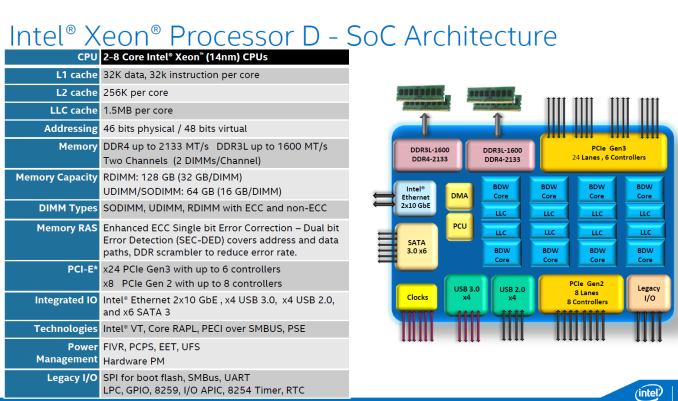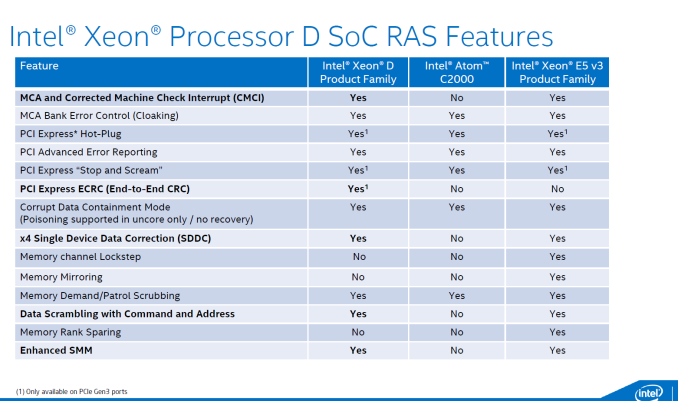The Intel Xeon D Review: Performance Per Watt Server SoC Champion?
by Johan De Gelas on June 23, 2015 8:35 AM EST- Posted in
- CPUs
- Intel
- Xeon-D
- Broadwell-DE
Broadwell in a Server SoC
In a nutshell, the Xeon D-1540 is two silicon dies in one highly integrated package. Eight 14 nm Broadwell cores, a shared L3-cache, a dual 10 gigabit MAC, a PCIe 3.0 root with 24 lanes find a home in the integrated SoC whereas in the same package we find four USB 3.0, four USB 2.0, six SATA3 controllers and a PCIe 2.0 root integrated in a PCH chip.
The Broadwell architecture brings small microarchitectural improvements - Intel currently claims about 5.5% higher IPC in integer processing. Other improvements include slightly lower VM exit/enter latencies, something that Intel has been improving with almost every recent generation (excluding Sandy Bridge).
Of course, if you are in the server business, you care little about all the small IPC improvements. Let us focus on the large relevant improvements. The big improvements over the Xeon E3-1200 v3 are:
- Twice as many cores and threads (8/16 vs 4/8)
- 32 GB instead of 8 GB per DIMM supported and support for DDR4-2133
- Maximum memory capacity has quadrupled (128 GB vs 32 GB)
- 24 PCIe 3.0 lanes instead of 16 PCIe 3.0 lanes
- 12 MB L3 rather than 8 MB L3
- No separate C22x chipset necessary for SATA / USB
- Dual 10 Gbit Ethernet integrated ...
And last but not least, RAS (Reliability, Availability and Servicability) features which are more similar to the Xeon E5:
The only RAS features missing in the Xeon D are the expensive ones like memory mirroring. Those RAS features a very rarely used, and The Xeon D can not offer them as it does not have a second memory controller.
Compared to the Atom C2000, the biggest improvement is the fact that the Broadwell core is vastly more advanced than the Silvermont core. That is not all:
- Atom C2000 had no L3-cache, and are thus a lot slower in situation where the cores have to sync a lot (databases)
- No support for USB 3 (Xeon D: four USB 3 controllers)
- As far as we know Atom C2000 server boards were limited to two 1 Gbit PHYs (unless you add a separate 10 GBe controller)
- No support for PCIe 3.0, "only" 16 PCIe Gen2 lanes.
There are more subtle differences of course such as using a crossbar rather than a ring, but those are beyond the scope of this review.













90 Comments
View All Comments
extide - Wednesday, June 24, 2015 - link
So, I was thinking last night, that this chip is THE PERFECT enthusiast chip! All Intel needs to do is release an unlocked and socketed version (although that would be complex because there is currently no platform for it ...) although if we could get at least an unlocked version on an enthusiast style board it would be awesome.Think about it:
8 Broadwell cores -- Great!
12MB L3 -- Great!
24 Lanes PCIe 3.0 -- More than 16 or even skylakes rumored 20, pretty good. You could do things like 16x + 8x, or 8x + 8x + 4x + 4x (the two 4x being m.2 ssd's) which would support CF or SLI quite well and some fast ssd's.
2ch DDR4 -- plenty for gaming and most enthusiast applications
Dual 10GbE -- Just added Gravvy here, but would def help adoption of 10g in the enthusiast realm.
COME ON INTEL!!
extide - Wednesday, June 24, 2015 - link
Also, I forgot to add:This would be a great intermediate between the current regular consumer stuff (LGA 115x) and HPDE (LGA 2011x) -- A lot of people really see the LGA 2011 platform as overkill, even for enthusiasts, and it gets so expensive, with quad channel ddr4 and all that. This chip just seems to make so much sense. Now if intel priced it no more than the $500 mark, that would be awesome. Imagine, if AMD was more competitive, we might actually have that5 scenario.... Hopefully Zen is just great!
Namisecond - Saturday, June 27, 2015 - link
Intel's tray price for this chip is listed at $199 for the 4-core and $581 for the 8-core. The price for the CPU+motherboard is almost $1K for the 8 core. which indicates the problem is not in the price of the chip itself.If you want cheap and low power consumption, I'd direct you to the S1150 platform with Xeon E3 V3 "L" series (13-45W) processors.
spikebike - Wednesday, June 24, 2015 - link
For a home machine, small server, workstation, or similar the Xeon D 1520 looks even better. Faster clock, 1/3rd the price, same maximum ram, ecc, etc. Sure it's got 4 cores/8threads instead of more, but for many use cases that's not a big limitation. In quite a few cases spending the $400 different on RAM or SSDs will make a bigger difference.hifiaudio2 - Thursday, June 25, 2015 - link
Where can you get a 1520? Google searching is not finding anything for sale...hifiaudio2 - Thursday, June 25, 2015 - link
If I cannot find the 1520 for sale, what is the best bang for the buck i3 and MB combo (want to use ECC ram as well) for a Media server/transcode/nas? Low TDP, etc..jaziniho - Thursday, June 25, 2015 - link
Any word on whether HP plan to make a Moonshot cartridge featuring Xeon D? the 45W TDP seems to match up with some of the previous chips they have used.jeffsci - Monday, June 29, 2015 - link
Why do the results use a variety of OSS compilers? For an Intel Xeon processor, the Intel compilers are the most reliable. Is Open64 actively developed for Intel processors? And switching from GCC 4.8 to 4.9 with different flags...how is this even remotely scientific?needforsuv - Saturday, July 11, 2015 - link
so they just done to the 'regular' 4/8 i7/e3 what they did to the C2D in making the C2Q but more sophisticated I like it now wheres that lga 115x 8 coretabascosauz - Sunday, July 19, 2015 - link
I hope that Mr. de Gelas will continue to learn and improve as a writer, because the grammar in this article is, in numerous places, rather iffy and AT has traditionally excelled in delivering detailed, grammatically correct content.